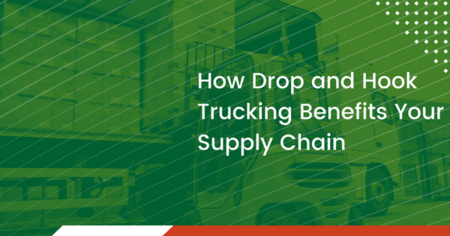Is your business seeing an increase in loading and unloading wait times, keeping your drivers off the road, and delaying your shipments? Switching to drop and hook trucking could be the solution. Depending on your cargo, drop and hook trucking can provide numerous benefits to your supply chain, namely its ability to save you time and money.
Live Load vs. Drop and Hook
Drop and Hook trucking
Drop and hook trucking allows the driver to drop off a full load to hook up to a preloaded or empty container at the same facility. Meaning the driver will drop the freight off without waiting for it to unload, saving time for the driver. It is also known as no-touch freight.
Live load in trucking
With live load trucking, the driver arrives at a specific time, and a warehouse distributor loads their container while they wait on-site. After the driver transports freight to the delivery point, they must wait for others to unload the cargo from their truck. With live loads, a driver receives a waiting fee. Waiting fees can present problems for shippers as what is called detention can occur. These delays in loading and unloading can keep drivers off the road and cost shippers time and money. For freight such as non-perishable food, however, live load trucking is the best option since food must remain at specific temperatures.
How drop and hook trucking benefits your supply chain
Drop and hook trucking has many advantages, making it an attractive option for shippers.
No contact
Drop and hook trucking allows a driver to deliver a shipment without touching cargo. This limits the possibility of freight being damaged during numerous physical manipulations while also sparing the driver from waiting on the warehouse staff to unload, which can sometimes take up to 48 hours.
Faster delivery, less downtime
The delivery process is much faster with a drop and hook option. Since the driver does not have to wait for cargo to unload, they can take another load and travel to their next destination more quickly. As a result, the driver has the potential to make more deliveries in a shorter period and make more money.
Drivers’ independence
While some companies do not need the driver to unload the cargo they are delivering, the driver may still need to wait on-site while the companies’ employees unload the freight. It means the driver must rely on others to unload the cargo before they can leave. As a driver, it can be frustrating if delays prevent you from returning to the road for your next pick-up.
Lower costs
Shippers sometimes pay a steep price while drivers wait for others to unload their containers. Known as a waiting fee, the shipper can eliminate that cost by utilizing drop-and-hook delivery and creating a win-win for both the shipper and driver.
Reduced emissions
Drop and hook trucking significantly reduces idle time. According to the US Department of Energy, less idle time implies cutting carbon and other environmentally dangerous emissions.
High tech capacity
Despite the logistical complexities of drop and hook trucking, it can provide room for implementing various technological innovations. Transportation companies continuously research how to help shippers save time when looking for required trailers during shipment. Innovations such as smart trailers equipped with easy identification systems have resulted.
Drop and hook trucking supplies the perfect opportunity to integrate automated loading/unloading. Besides facilitating physical operations, you can prevent shippers from traveling empty miles and make the most of transport capacity by connecting drop and hook software to your transportation management system (TMS).
Drop and hook trucking challenges
Although drop and hook trucking has many appealing benefits to drivers, it has drawbacks.
Operational complexity
Drop and hook transportation requires shippers to stay constantly updated on the location and capacity of available vehicle units. It is the only way to quickly retrieve a suitable trailer for every drop and hook shipment you handle. Shippers usually rely on additional employees searching for the needed capacity to face this challenge without disruptions. Unfortunately, this process is time-consuming and practically eliminates beneficial spot shipping options.
Required space
A shipper must have adequate space for drivers to drop off their containers and “house” empty or preloaded containers. For this reason, drop service is challenging to manage for shippers/receivers who do not have enough yard space for stagnant containers.
In addition to this, dropping a fully loaded container and replacing it with an empty trailer to match can be time-consuming. Smaller operations can get challenging without yard employees overseeing moving trailers in the loading area.
Extended lead time
A drop and hook service requires a good amount of lead time. Shippers need a proper warning that the driver will be dropping their container off and hooking to one from their yard.
Although dropping a container is convenient for drivers because they could haul other loads immediately after, it takes planning on the shipping side. It can also decrease the ability to adjust to urgent shipments, thus making drop and hook services impractical for last-minute buyers.
Transportation of perishables
Drop container service becomes infeasible for temperature-controlled perishable items such as seafood, poultry, or pharmaceuticals since refrigerated containers cannot maintain their temperature without the truck. And because perishable items need scheduled unloading times, drivers cannot drop off a refrigerated container and pick up another.
Although it is only for some businesses, drop-and-hook trucking service could positively impact the right company. PLS Logistics Services will help you get a tailored shipping experience based on your exact logistics needs and budget. Need help with transportation errands? Get a free freight quote today!


